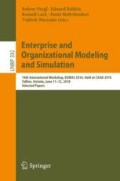Abstract
Model-driven development approach to software engineering requires precise models defining as much of the system as possible. OntoUML is a conceptual modelling language based on UFO, which provides constructs to create ontologically well-founded and precise conceptual models. In the approach we utilize, OntoUML is used for making conceptual models of software application data. Such a model is then transformed into its proper realization in a relational database, preserving all the implicit constraints defined by various types of universals and relations in the original OntoUML model. In this paper, we discuss possible optimizations of the transformation of Kinds and Subkinds – rigid sortal universal types, a backbone of OntoUML models.
Access this chapter
Tax calculation will be finalised at checkout
Purchases are for personal use only
Notes
- 1.
According to the ranking published on https://db-engines.com/en/ranking in February 2018, 7 of 10 most popular DBMSs are relational.
- 2.
Enterprise Architect is a popular commercial CASE tool used for creating models, http://www.sparxsystems.com.au/products/ea/index.html.
- 3.
Enterprise Java Beans, http://www.oracle.com/technetwork/java/javaee/ejb/index.html.
- 4.
- 5.
In Enterprise Architect, which we use for the modelling purposes, the immutability of attributes is depicted by the constraint {readOnly}.
References
Aleksić, S., Ristić, S., Luković, I.: An approach to generating server implementation of the inverse referential integrity constraints. In: Proceedings of the 5th International Conference on Information Technologies, ICIT, May 2011
Aleksić, S., Ristić, S., Luković, I., Čeliković, M.: A design specification and a server implementation of the inverse referential integrity constraints. Comput. Sci. Inf. Syst. 10(1) (2013)
Andreeva, E., Poletaeva, T., Abdulrab, H., Babkin, E.: One solution for semantic data integration in logistics. In: Barjis, J., Pergl, R., Babkin, E. (eds.) EOMAS 2015. LNBIP, vol. 231, pp. 75–86. Springer, Cham (2015). https://doi.org/10.1007/978-3-319-24626-0_6
Benevides, A.B., Guizzardi, G., Braga, B.F.B., Almeida, J.P.A.: Assessing modal aspects of OntoUML conceptual models in alloy. In: Heuser, C.A., Pernul, G. (eds.) ER 2009. LNCS, vol. 5833, pp. 55–64. Springer, Heidelberg (2009). https://doi.org/10.1007/978-3-642-04947-7_8
Carolla, M., Spitta, T.: Methodological aspects of a data reference model for campus management systems. Working Paper (2014)
Carraretto, R.: Separating ontological and informational concerns: a model-driven approach for conceptual modeling. Master thesis, Federal University of Espirito Santo (2012)
Egea, M., Dania, C.: SQL-PL4OCL: an automatic code generator from OCL to SQL procedural language. Softw. Syst. Model., 1–23 (2017)
Ghezzi, C., Jazayeri, M., Mandrioli, D.: Fundamentals of Software Engineering, 2nd edn. Prentice Hall, Upper Saddle River (2002)
Guizzardi, G.: Ontological Foundations for Structural Conceptual Models, vol. 015. University of Twente, Enschede (2005)
Guizzardi, G.: Agent roles, qua individuals and the Counting Problem. In: Garcia, A., Choren, R., Lucena, C., Giorgini, P., Holvoet, T., Romanovsky, A. (eds.) SELMAS 2005. LNCS, vol. 3914, pp. 143–160. Springer, Heidelberg (2006). https://doi.org/10.1007/11738817_9
Guizzardi, G.: The problem of transitivity of part-whole relations in conceptual modeling revisited. In: van Eck, P., Gordijn, J., Wieringa, R. (eds.) CAiSE 2009. LNCS, vol. 5565, pp. 94–109. Springer, Heidelberg (2009). https://doi.org/10.1007/978-3-642-02144-2_12
Guizzardi, G., Wagner, G.: A unified foundational ontology and some applications of it in business modeling. In: CAiSE Workshops, pp. 129–143 (2004)
Kuskorn, W., Lekcharoen, S.: An adaptive translation of class diagram to relational database. In: International Conference on Information and Multimedia Technology, ICIMT 2009, pp. 144–148, December 2009
Mellor, S.J., Clark, A.N., Futagami, T.: Model-driven development. IEEE Softw. 20(5), 14 (2003)
OMG: UML 2.5, March 2015. Accessed 12 Mar 2018
Oriol, X., Teniente, E.: Incremental checking of OCL constraints through SQL queries. In: Proceedings of the 14th International Workshop on OCL and Textual Modelling, pp. 23–32 (2014)
Pergl, R., Sales, T.P., Rybola, Z.: Towards OntoUML for software engineering: from domain ontology to implementation model. In: Cuzzocrea, A., Maabout, S. (eds.) MEDI 2013. LNCS, vol. 8216, pp. 249–263. Springer, Heidelberg (2013). https://doi.org/10.1007/978-3-642-41366-7_21
Ramakrishnan, R., Gehrke, J.: Database Management Systems, 3rd edn. McGraw-Hill, Boston (2002)
Rybola, Z., Pergl, R.: Towards OntoUML for software engineering: introduction to the transformation of OntoUML into relational databases. In: Pergl, R., Molhanec, M., Babkin, E., Fosso Wamba, S. (eds.) EOMAS 2016. LNBIP, vol. 272, pp. 67–83. Springer, Cham (2016). https://doi.org/10.1007/978-3-319-49454-8_5
Rybola, Z., Pergl, R.: Towards OntoUML for software engineering: transformation of anti-rigid sortal types into relational databases. In: Bellatreche, L., Pastor, Ó., Almendros Jiménez, J.M., Aït-Ameur, Y. (eds.) MEDI 2016. LNCS, vol. 9893, pp. 1–15. Springer, Cham (2016). https://doi.org/10.1007/978-3-319-45547-1_1
Rybola, Z., Pergl, R.: Towards OntoUML for software engineering: transformation of kinds and subkinds into relational databases. Comput. Sci. Inf. Syst. 14(3), 913–937 (2017)
Rybola, Z., Richta, K.: Possible realizations of multiplicity constraints. Comput. Sci. Inf. Syst. 10(4), 1621–1646 (2013)
Sobotka, P.: Transformation from OCL into SQL. Master thesis, Charles University, Prague, Czech Republic, May 2012
Zamborlini, V., Guizzardi, G.: On the representation of temporally changing information in OWL. In: 2010 14th IEEE International Enterprise Distributed Object Computing Conference Workshops (EDOCW), pp. 283–292. IEEE (2010)
Author information
Authors and Affiliations
Corresponding author
Editor information
Editors and Affiliations
Rights and permissions
Copyright information
© 2018 Springer Nature Switzerland AG
About this paper
Cite this paper
Rybola, Z., Pergl, R. (2018). Towards OntoUML for Software Engineering: Optimizing Kinds and Subkinds Transformed into Relational Databases. In: Pergl, R., Babkin, E., Lock, R., Malyzhenkov, P., Merunka, V. (eds) Enterprise and Organizational Modeling and Simulation. EOMAS 2018. Lecture Notes in Business Information Processing, vol 332. Springer, Cham. https://doi.org/10.1007/978-3-030-00787-4_3
Download citation
DOI: https://doi.org/10.1007/978-3-030-00787-4_3
Published:
Publisher Name: Springer, Cham
Print ISBN: 978-3-030-00786-7
Online ISBN: 978-3-030-00787-4
eBook Packages: Computer ScienceComputer Science (R0)

